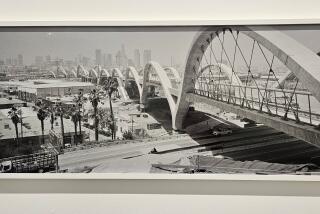Set It at F.11 : WALKER EVANS: A Biography, <i> By Belinda Rathbone (Houghton Mifflin: $27.50, 358 pp. and 32 pages of illustrations)</i>
- Share via
Belinda Rathbone has taken up a difficult challenge in producing the first-ever biography of photographer Walker Evans, who died 20 years ago this May. She tells the story of a sensitive young man from St. Louis whose parents separated while he was a teen-ager and who, after struggling in various schools, managed to get through one year at Williams College before ending his formal education. In 1928, at age 25, Walker Evans was inexplicably drawn to the camera, at a time when being a professional photographer was at best, comical. His life, his choice of photography as a medium and his complete dedication to it, would change all that.
Inspired by meetings with several artists, including the poet Hart Crane, photographer Paul Grotz and the multitalented Lincoln Kirstein (whom he met in a bookstore), Evans came to believe in the unique ability of the camera to describe “the extraordinary visual reality” of his own era. At times, “going almost mad with possibilities,” he used the camera, usually an eight-by-ten inch Deerdorf view camera, but occasionally a Leica, to make the devastating portraits of American people and streets and architecture that are his legacy. His first subjects were Coney Island, New England architecture and posters.
Rathbone tries, with some success, to put the genius of his work into words. But in the best of his pictures, she admits, “the real subject remains elusive.” So does the photographer. By the end of the book one can hardly believe that this peculiar and withdrawn man, who collected postcards and later plain junk in his home in Connecticut, could have been the human spirit behind these remarkable photographs, a selection of which are reproduced in the book. But I am sure Evans would have preferred it that way. His work was about what was outside of himself, not about himself. As Rathbone writes: “They exuded an austere faith in pure record; at the same time they possessed a warmth, and an almost haunting sense of familiarity.”
His photograph made from a Saratoga Springs hotel room on a rainy day has stupefying power and dignity, yet it is as common as a glance out the window onto almost any downtown city street.
He was shy, not exactly the right thing for a photographer. If that wasn’t enough, he suffered from inertia. Completely dedicated to serious photography, he could barely make a living when, in 1935, he was among the first to be hired by Roy Stryker for what would become the photography unit of the Farm Security Administration (FSA). His concept of documentary, which he created in the previous eight years of photographing in the streets, was instrumental in forming the unit and guiding future FSA photographers in subject and attitude. The group would eventually include Dorothea Lange, Russell Lee, Carl Mydans and Ben Shawn, among others. Shawn was Evans’ roommate and disciple, who, upon demanding that Evans teach him how to make photographs, received the now famous answer: “Set it at f.11,” still sound advice for a cloudy day.
The photographs they made, a product of government money spent on the arts during a kinder, gentler time in our history (the Depression!) are a milestone in American photography. Rathbone’s descriptions of what happened then and later in Alabama where Evans traveled with James Agee, who had landed the assignment from Fortune magazine, are among the best parts of the book. Evans survived under Stryker by ignoring him and doing whatever he wanted to do. Usually that meant photographing architecture and signs; sometimes it meant doing absolutely nothing.
Finally, in 1936, he left to join Agee in Alabama and with him created what, for my generation, would define journalism, the now revered, then remaindered book, “Let Us Now Praise Famous Men.” Agee wanted to stay with the families of tenant farmers but lost his nerve and fled after the first day. When his car got stuck in the mud, he walked back to the farm and spent the night. It was the birth of a new, personal and unusually honest journalism. They stayed for three weeks and Evans did his part in a series of brilliant, clear, unsentimental, f.64 sharp and overwhelmingly beautiful photographs while he slept in the closest hotel. Agee agonized over his text for years, and finally handed it in, assuming it would be the flop they all expected. Six hundred copies were sold.
Anyone interested in media politics and photography will be fascinated by Rathbone’s revelations of the personalities and maneuvering behind Walker Evans epoch-making 1938 exhibit at the Museum of Modern Art. It shows that revolutions, which is what Evans’ work would cause in the arts, are no accident. When the show book, “American Photographs,” came out the following year, it sent shock waves across America, establishing documentary photography as a form and Evans as the practitioner of it. Tellingly, Ansel Adams, who saw the book as an Eastern, Leftist and depressing view of America, hated it.
Evans’ productive years in the South, and briefly, in Havana, are fascinating to read about, but there are other less interesting times in his life when the book seems a cruel look at a man who would rather have us look at his pictures.
In 1955, his close friend Agee drank himself to death. Evans reissued “Let Us Now Praise Famous Men” in time for the 1960s, doubling the number of his photographs and publishing many of them sideways, something almost no publisher would do for anyone then or now, but Walker Evans was a fanatic when it came to the presentation of his work and had a way of getting what he wanted. Within his mousy little skull was the brain of perhaps the greatest American photographer of the 20th Century. Not that it helped him all that much. He often needed to be taken by the hand to go out into the world and photograph. In 1941 it was the young hand of Helen Levitt, a “kid from Brooklyn,” who had been photographing as a teen-ager and was befriended by Agee and Evans. She went with Evans into the New York City subways, where, while he leaned against her, Evans surreptitiously made portraits of the people sitting across the aisle from them. Never in a rush, he published the pictures 20 years later.
Evans never stopped making pictures; he never lowered the terribly high standards he set for his work, and by example, for everybody else’s work.
A 1968 picture made directly into the open top of a New York City trash can makes the trash look like a Greek ruin. It could have been the light, but more likely it was the light inside his mind. He loved the road and the road signs and the billboards. Now the road he loved is gone, and the country that he loved to photograph, sometimes in ruins, is just about gone too. He made pictures of junk and signs and then he started unbolting the signs and taking them home. He collected aluminum pop tops and other junk and took that home too.
One day George Rinehart, a dealer from New York, came to Evans’ small home in Old Lyme, Connecticut, and gave him $100,000 for all the work he had ever done. The dealer loaded it into his Rolls Royce and drove away. A few months later he came back and for another $50,000 bought the negatives. That was in 1974. The next year Walker Evans died.
In his pictures, preserved in a number of books, in the negatives and prints of the FSA (U.S. Government property) and in our hearts and memories he left us perhaps the greatest homage to 20th-Century America ever made.
More to Read
Sign up for our Book Club newsletter
Get the latest news, events and more from the Los Angeles Times Book Club, and help us get L.A. reading and talking.
You may occasionally receive promotional content from the Los Angeles Times.







